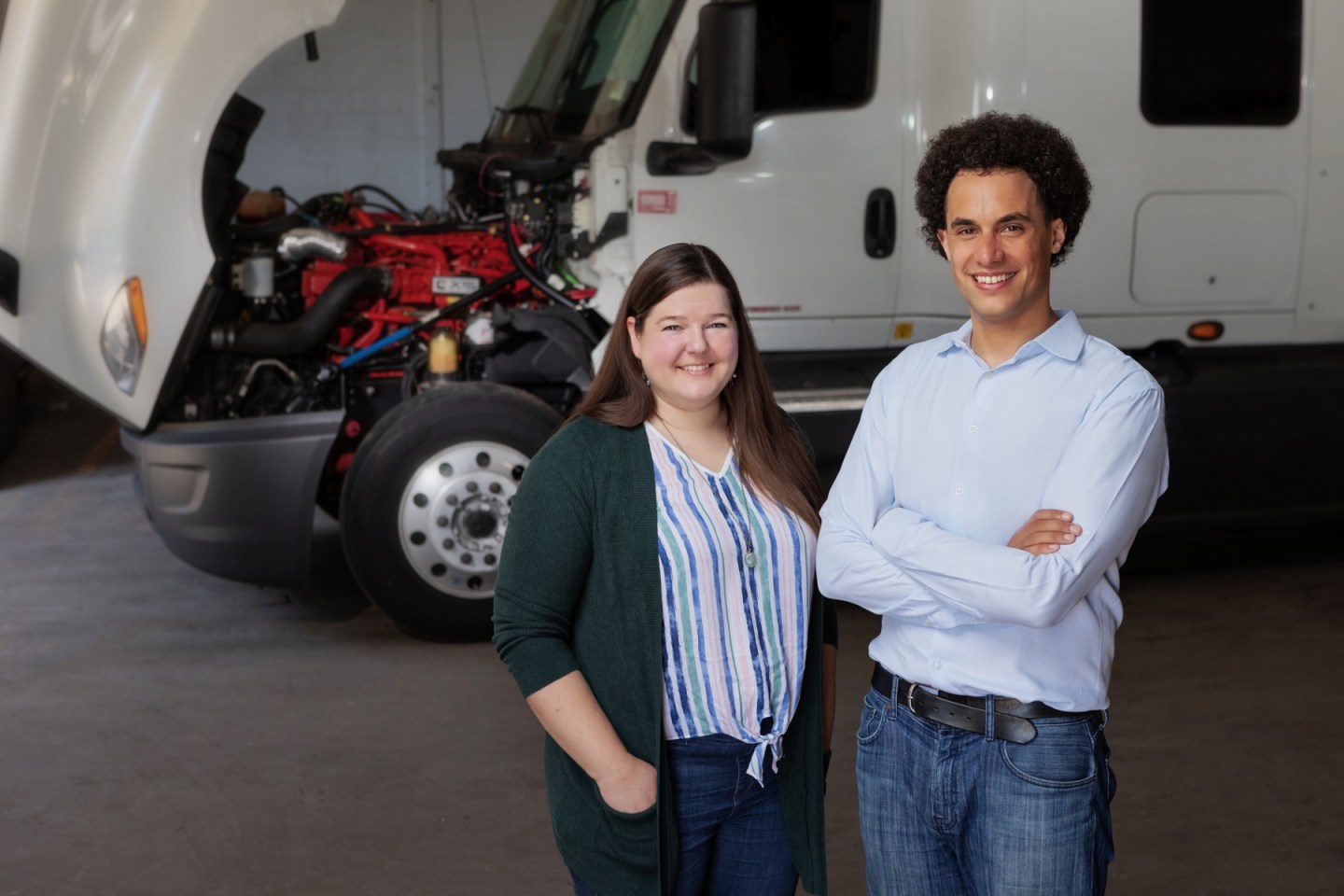When Julie Blumreiter and B.J. Johnson met as mechanical engineering Ph.D. students in Stanford University’s Advanced Energy Systems Laboratory, their advisor Professor Chris Edwards offered them a piece of advice: never forget that the world is diverse and energy is a global issue.
Yes, we have to achieve sustainability, he told them. But there are close to a billion people in the world who don’t have basic access to electricity, and few things improve quality of life in those communities as much as access to diesel engines. Diesel trucks connect them to food and other essential goods; diesel generators bring light and refrigeration.
“And so what we set out to do as a company was decouple the economic value of the diesel engine from its environmental challenges, which are not associated with the engine, but are actually challenges with the fact that the engine currently requires petroleum diesel fuel,” say Johnson, CEO of ClearFlame Engine Technologies, the Geneva, Ill.-based startup he and Blumreiter founded in 2016.
In other words, they wanted to power a “diesel” engine with some other fuel that was cheap, plentiful—and clean.
In the six years since its founding, ClearFlame has done that, modifying diesel engines so they run on low-carbon fuels like ethanol and methanol, significantly cutting emissions (and perhaps mileage costs) in the process.
In October 2021, ClearFlame raised a $17 million Series A funding round led by Bill Gates-founded Breakthrough Energy Ventures and including ag vehicle manufacturer John Deere. And this month, ClearFlame announced it had signed agreements with truck refitting firms to add its technology to existing diesel engines, and had rolled out its first pilot fleet trial with a ClearFlame truck running on ethanol.
Along the way, ClearFlame has waded into a tense climate change debate over whether an internal combustion engine can ever be considered environmentally sound in a world that has electric cars—and if it’s defensible to turn food into fuel.
Dirty engines
Trucking needs to be decarbonized—that much is not up for debate. About a quarter of worldwide CO2 emissions are attributable to transportation. Of that, about 45% comes from passenger vehicles, an industry already in the midst of a historic shift to electric vehicles. Another 30% of those emissions stems from trucking, an industry that has so far failed to electrify itself. Electric trucks have made inroads in short to medium distances, but they haven’t done so for longer (over 100 mile) trips that account for 70% of U.S. freight.
Long-haul truck firms complain about the short range and long refueling times of electric trucks. The newest Volvo VNR Electric semi advertises a range of 275 miles, while the Freightliner eCascadia goes for 230 miles; both take 90 minutes to get to an 80% change. Diesel trucks, on the other hand, can travel 1,000 miles per tank (though drivers can’t go that far without rest) and refill in 20 minutes.
Alternative Fuels
In the Stanford lab, Johnson and Blumreiter proved that if you ran a diesel engine hotter than normal, the engine could run on a whole range of low-carbon liquid fuels like ethanol, methanol, and ammonia.
“The fundamental discovery was that we could run a diesel engine, getting the same performance, on any fuel,” says Blumreiter. “That allows us to choose fuels based on some other desirable attributes than their ignition characteristics, like cost, regional availability, carbon intensity, or how clean they burn.”

Getting the diesel engine to run hotter was the tricky part. Low carbon fuels like ethanol and methanol ignite at higher temperatures than diesel, so if they were used in a normal diesel engine they would fail to combust and the engine would sputter out.
To tackle this issue, in 2017 Johnson and Blumreiter moved from Stanford to the Argonne National Laboratory in the Chicago suburbs. There, they joined a new program called Chain Reaction Innovations that had been set up to bridge the so-called “valley of death” between idea and proof of concept for startups in manufacturing and energy.
They spent the next two years experimenting with how to tweak a Caterpillar test engine to prove their concept in a real-world setting. Ultimately, Blumreiter and Johnson got the diesel engine hotter by modifying 10-15% of the parts. For example, they removed a lot of the traditional cooling components so it would be hot enough to ignite low carbon fuels.
“We changed some of the air and exhaust plumbing in the engine to basically let the air and exhaust come hotter into the engine than it would have otherwise,” says Johnson. “And then we changed the fuel injection systems to be compatible with these lower carbon fuels, which usually means engineering for lower viscosity.”
With the science proven in an engine, ClearFlame raised a $3 million seed funding round in early 2020 led by Clean Energy Ventures, just before the COVID-19 pandemic took off.
Hitting the Road
Ethanol is typically made from corn or sugarcane and still has some carbon footprint, including from the tractors and fertilizer used to grow it. But, ClearFlame says, running one of the company’s retrofitted diesel engines on ethanol reduces CO2 emissions by 42% compared to diesel. In fact, the company says a ClearFlame engine emits 23% less carbon than battery EVs because of the mix of fuels used to generate electricity on the national grid. And because ethanol is a “short” molecule with two carbon atoms—compared to the 16 in a typical diesel chain—a ClearFlame engine produces 99% less soot particulate emissions, the company says.

Perhaps equally as interesting for trucking firms, an outside study contracted by ClearFlame before Russia’s invasion of Ukraine found that running a truck on a ClearFlame engine costs eight cents less per mile than a diesel one. At diesel’s highest price during the war, that savings rose to 25-30 cents per mile, Johnson says.
In the last year, ClearFlame has retrofitted its first four trucks, Blumreiter says, and now has 35 employees. The company has run trucks on its engines for “tens of thousands” of miles, Johnson says. In September, it announced that it had signed deals with Reviva, an engine rebuilder, and Vander Haag’s, a truck service chain, to integrate ClearFlame’s kit into Cummins X15 truck engines and install them in Class 8 trucks, the largest class on U.S. roads.
The ClearFlame retrofit process costs between $40,000 and $50,000. A typical new diesel semi costs some $150,000 and gets an engine rebuild (about $30,000) after a million miles. Johnson argues that the added expense of a ClearFlame retrofit is justified because it pays for itself in 12 to 24 months through lower per-mile costs. Vander Haag’s chief business officer Eric Krikke says a retrofit should take about two weeks.
The Debate
Not everyone is sure that ClearFlame’s concept is the best way to decarbonize trucking.
Electric trucks and vans can already cover short and medium trips and their range is expanding, critics argue; plus, there is no national network of service stations that offer pure ethanol. (Blumreiter notes that trucking fleets, which already have diesel tanks installed at their depots, could repurpose an already installed tank or install a new one for tens of thousands of dollars, and trucks stops could follow: “I’m expecting that to happen, because the cost of liquid fueled infrastructure is so low.”)

There are also philosophical arguments against low carbon fuels like ethanol and methanol. Using them assumes that carbon emissions are okay as long as they don’t come from pumping fossil fuels out of the ground. But, “hardcore decarbornizers say all carbon is evil,” notes Christoph Stuermer, automotive practice lead at Vindelici Advisors.
Ethanol elicits more direct criticism. “There is a fear that this stuff will become so economically viable that the cultivation of crops for first-generation biofuels will crowd out food and animal feed and therefore increase food prices or increase food shortages,” Stuermer says. “Americans could pay more to put it in their cars than African kids could pay for it to eat.”
Kyle Teamey, BEV’s deal lead on the ClearFlame investment, argues that the point of ClearFlame is not to design engines for plant-based ethanol, but rather for a slew of new light fuels like methanol that can be produced from water, CO2 and renewable electricity. “There are new energy carriers emerging. And that’s why I’m excited about this…We’re not looking to get into a fight over how best to use crop lands, we’re looking to the next phase of the evolution of the market.”
Fortune covers the world of innovation in Breakthrough. You can read previous Breakthrough columns here.












